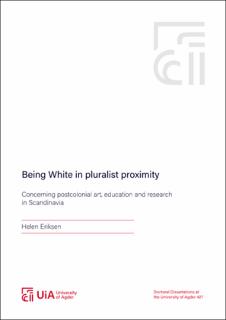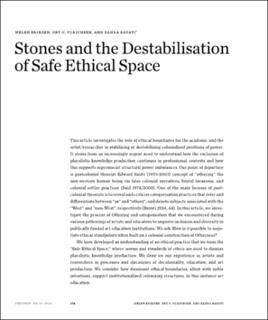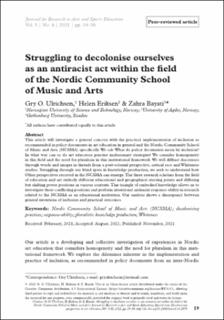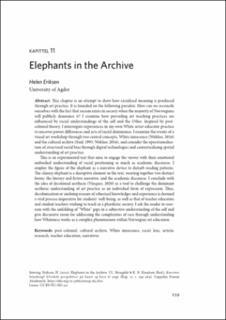| dc.contributor.author | Eriksen, Helen | |
| dc.date.accessioned | 2023-09-19T09:16:35Z | |
| dc.date.available | 2023-09-19T09:16:35Z | |
| dc.date.created | 2023-09-11T11:21:41Z | |
| dc.date.issued | 2023 | |
| dc.identifier.citation | Eriksen, H. (2023). Being White in Pluralist Proximity: Concerning postcolonial art, education and research in Scandinavia. [Doctoral dissertation]. University of Agder. | en_US |
| dc.identifier.isbn | 978-82-8427-143-9 | |
| dc.identifier.issn | 1504-9272 | |
| dc.identifier.uri | https://hdl.handle.net/11250/3090355 | |
| dc.description.abstract | This combined doctoral thesis comprises 50% theory and 50% art practice. It emerges through the intersections of art, education and research. I share my evolving understanding of working processes in those fields as the sum of history, geographical context, materiality and an imaginary. It includes three peer-reviewed texts (Eriksen, 2022; Eriksen et al., 2020; Ulrichsen et al., 2021), three exhibitions (Dijkstra & de Bie, 2018; Eriksen et al., 2018a, 2018b) a film (Solmaz, 2022) and other artist practices such as drawing, collage and object-making. Its content takes a form that seeks to disrupt the binary division between academic text/practice and artistic research practice. I explore the paradox of how the majority of Scandinavians denounce racism while reconciling themselves with the fact that it exists (cf. Wekker, 2016). I explore this through my entanglement, as a White European female artist, with a working-class background in art, education and research. I discuss how artists generally and my-self specifically experience aesthetic decision-making in post-colonial Scandinavia. My position as the subject-researcher is located not only through peer-reviewed texts but also in vignettes included in the metatext based on my memories, private journals, and field journals/notes from my professional life. I use a diffractive method based on the theory of agential realism (Barad, 2007). This method inspired me to think through and with post-colonial scholars (Ahmed, 2021; Khanna, 2020; Said, 1994, 2003; Spivak, 1988) and thinkers in critical race and Whiteness theories (Bayati, 2014; Ignatiev, 2009; Matias, 2016; Wekker, 2016; Werner & Björk, 2014). I explore the significance of the embodied colonial cultural archive (Said, 1994; Wekker, 2016) and emotion (Khanna, 2020) and their role in the cultural production of racial stereotypes. Dominating European practices in art, education and research emerge as complicit in the structures of White 10 11 supremacy and rooted in the philosophical foundations stemming from modernity. Globally dominating aesthetic/ethic ideologies of artistic autonomy and freedom and academic ethical norms are seen to converge in a “safe ethical space” to protect dominating White knowledge production and exclude other knowledges (Eriksen et al., 2020). It is only in the proximity of other knowledges, in uncomfortable situations of conflict, that my Eurocentric White understanding of these practices is challenged (Ulrichsen et al., 2021) and is conceptualised as being in pluralist proximity. I would like to consider this thesis a decolonising praxis (Kuokkanen, 2010; Walsh, 2018), as it is hopefully an intervention in the context in which it is researched, supervised, and published. The form of the final 100% thesis itself can be seen as an insistence on the right to question what Biggs and Büchler (2010) identify as very different dissemination practices of artistic and academic communities. It is a thesis that bulges in every direction. I aim to disseminate the same textual and visual materials to different audiences and maintain the complexity and entanglements within them. | en_US |
| dc.language.iso | eng | en_US |
| dc.publisher | University of Agder | en_US |
| dc.relation.ispartofseries | Doctoral Dissertations at the University of Agder; no. 427 | |
| dc.relation.haspart | Paper I: Eriksen, H., Ulrichsen, G. O. & Bayati, Z. (2020). Stones and the Destabilisation of Safe Ethical Space. Periskop, 24, 156-171. Published version. https://doi.org/10.7146/periskop.v2020i24.126184. Full-text is available in AURA as a separate file. | en_US |
| dc.relation.haspart | Paper II: Ulrichsen, G. O., Eriksen, H. & Bayati, Z. (2021). Struggling to decolonise ourselves as an antiracist act within the field of the Nordic Community School of Music and Arts. Journal for Research in Arts and Sports Education, 5(4), 19-38. Published version. https://doi.org/10.23865/jased.v5.2978. Full-text is not available in AURA as a separate file. | en_US |
| dc.relation.haspart | Paper III: Eriksen, H. (2022). Elephants in the archive. In L. Skregelid & K. Knudsen (Eds.), Kunstens betydning? Utvidede perspektiver på kunst og barn & unge (pp. 239–264). Cappelen Damm Akademisk. Published version. https://doi.org/10.23865/noasp.163.ch11. Full-text is not available in AURA as a separate file. | en_US |
| dc.rights | Attribution-NonCommercial-NoDerivatives 4.0 Internasjonal | * |
| dc.rights.uri | http://creativecommons.org/licenses/by-nc-nd/4.0/deed.no | * |
| dc.title | Being White in Pluralist Proximity: Concerning postcolonial art, education and research in Scandinavia | en_US |
| dc.type | Doctoral thesis | en_US |
| dc.description.version | publishedVersion | en_US |
| dc.rights.holder | © 2023 Helen Eriksen | en_US |
| dc.subject.nsi | VDP::Humaniora: 000::Kunsthistorie: 120 | en_US |
| dc.source.pagenumber | 87 | en_US |
| dc.identifier.cristin | 2173929 | |




